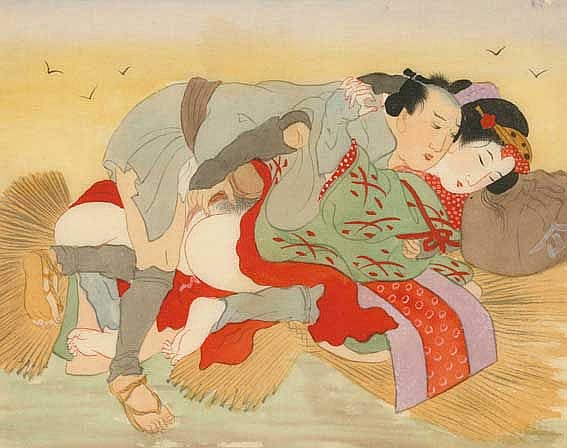
In the Edo period, one of the driving forces of the economy was the rice production. Rice planting happened (and still happens) in the spring, cultivation in the summer, and harvest in the fall. The Japanese style of rice-growing adjusts its range of procedures according to the flow of the seasons. Rice yields were also a measurement of a lord’s wealth.
Emphatic Part
As is well known, ukiyo-e (lit. ‘Floating world) and shunga art in particular, are also strongly linked to the seasons (hence its literal translation ‘Spring picture’), and for that reason it was an emphatic part of its imagery.
Fall
Below you can check out images that are a fusion of the seasons, rice production and libidinous adventures. They all refer to the rice harvesting and therefore take place during the fall…

Painting of a ‘Libidinous encounter during the rice harvest‘ (c.1850) by an important Utagawa school artist
Keisai Eisen
During the harvesting of the rice a farmer is having intercourse with a female companion. This painting is inspired by a Keisai Eisen (1790-1848) design entitled ‘Snows of Sano (Sano no yuki)’ from the series ‘A Light Spring Snow (Haru no usuyuki)’ which was issued in 1822. That image features a couple in the snow.

‘Intimate encounter during the rice harvest‘ (c.1910/20) by an unknown Taisho era artist
Sickles
A light-hearted scene between two young sensual laborers with de inserting image showing their prior flirtatious behavior. The sickles are a striking detail.

‘Encounter in the rice field‘ (c.1900) by an unknown Meiji artist
Scarecrow
During a windy autumn afternoon while the woman leans over a straw. The scarecrow standing in the rice field behind them is an amusing detail.

‘A country lad stimulating the private parts of a peasant girl with his fingers. They are both wearing their work clothing hand-covers and leggings.‘ (c.1820s) by Keisai Eisen

Painting inspired by the previous Eisen print (c.1900)

‘An oiran has a secret intimate rendezvous with her lover behind the rice-straws‘ (c.1820s) from the series called ‘Mitsukumi sakazuki‘ (c.1820s) by Keisai Eisen
Click HERE and discover the many articles on Keisai Eisen sensual art…!!










